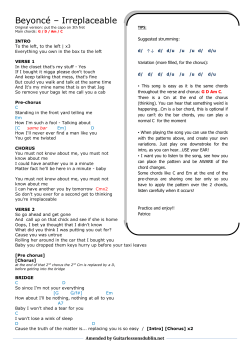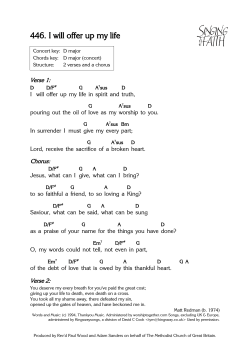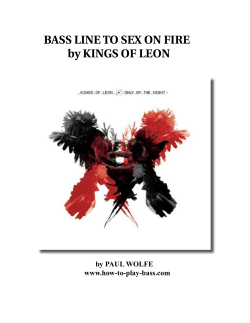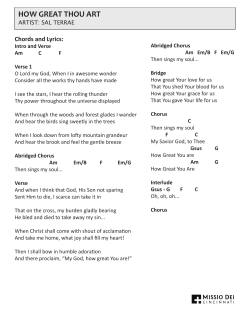
“Cat's in the Cradle” by Harry Chapin
“Cat's in the Cradle” by Harry Chapin Step-by-Step Instruction For Learning to Play You will play this song using basic finger picking. You might be tempted to use a pick because there there are a number of places where you will be strumming, but there will also be many sections (starting with the Introduction) where you need to pick and “pinch” – using the thumb on the bass note while simultaneously picking a treble note with your finger. The other thing important to mention is capo placement. You can use a capo on the eighth fret in order to be in the same key as the original recording. But not everyone is comfortable using their fingers up that high, especially on an acoustic or a classical guitar. So feel free to move down to the seventh, sixth or fifth fret if that’s more comfortable for you. Just remember that you’re not going to sound the same as the original recording of the song. While there are all sorts of ways to finger this next A5 chord, one suggestion is to go with your index finger on the D string and your middle finger on the G string. This frees up your ring finger for performing the pull-off on the second fret of the high E (first) string at the start of the second measure. You can them choose between using either your ring finger or your pinky to get the D note (third fret of the D string) later that measure. This arrangement is meant to simply be a starting place for your own ideas. So you might, for instance, want to pair the E note located at the second fret of the D string to go along with the fist play of the open high E (first) string. That will definitely add a little bit of body to the melody of the Introduction. Here are the first 2 measures of the Introduction- For this next part of the song, in Measure Four, you can either take your fingers in the A5 shape and simply move them to the next lower strings, or you can make a little jump and fret your Em the way most people tend to do, with their middle finger on the A string and the ring finger on the D string. This brief side trip into 2 /4 timing lasts only a single measure. Measure Five finds us back in 4 /4 timing, and we’ll be here until we again come across the Introduction section when it is played between the first chorus and the second verse. Here we give ourselves a few resounding strums of the A5 chord. Many transcriptions of this song are content to finish the Introduction with several measures of the A chord (A major, that is) being played until the verse starts up. However, you may decide that you like to add a little “turnaround” (or a “riff to play while we’re waiting for the beginning of the verse and we’re stuck on the same chord for a while”) . You could use an Am chord to give us our shape to play the riff. First we get the Am chord set up and then we pinch the open A string while picking the B string (where our index finger is on the first fret) at the same time. After the pinch, pull-off your index finger in order to sound the open B string and then pick the G and D strings to complete the arpeggio. Having an Am chord may seem a little strange, especially after making such a big deal about the tonality of this song, but it works well as a foreshadowing of the C chord that’s coming up as a short, condensed reprise of the chords from Measures Three and Four. Indeed, many versions of Cat’s in the Cradle use the open A string for the bass note in those two measures. But if you listen to the original recording, you can hear the bassist playing the C and B notes that we’re playing on the A string. And even though we’re playing without a bass player, that doesn’t mean we should sound like we don’t care about the bass. There are all sorts of ways to strum this. The strumming pattern is not so important as making sure the song does not sound stiff and lifeless. You can put your own personality into the song by using a unique strumming pattern. Or, you can try to stay as close to the original song as possible. It's entirely up to you. For the next section of the song, it only makes sense to use the same melody from the Introduction as a guide for putting together a rhythm/picking pattern for this section of the song. You should be able to hear (as well as to see from the music notes) that the first three measures are the same general pattern. We obviously changed some of the notes when we changed chords from A5 to C, and we also obviously changed the string of the bass note when we got to the D chord. We play this “first section” of the verse twice through. Then we move to the “second section, which is just a simple walking bass line / arpeggio combination. In the above section of music, you should be able to hear (as well as to see) that the first three measures are the same pattern. We obviously changed some of the notes when we changed chords from A5 to C. And we also obviously changed the string of the bass note when we got to the D chord. As mentioned, we play this “first section” of the verse twice through. Then we move to the “second section, which is just a simple walking bass line / arpeggio combination. For the next section, the idea is fairly straightforward. Pick the bass note with your thumb and then play an arpeggio on the D, G and B strings. We’ll make an exception for the last half of the second measure (where we’re playing the Em/D chord – probably the guitarist’s all time favorite chord of all, by the way!) where the bass note is the open D string, so we alter the pattern slightly. Also, concerning the third and fourth verses of our song, the last line of lyric is dropped in the 3rd verse, which means that we need to go from Measure Three of this section directly to the last two measures. You can, if you’d rather, go straight from the second measure to the fifth. In the last verse, the entire second section of the verse is played twice in a row. The second time starts with the line “…and as I hung up the phone…” To add a little variation at this point, you might want to try going with less accompaniment during the repeat, switching from eighth note arpeggios to deliberately pinched half notes, like this: Next is the Chorus and the Bridge. The majority of the chorus is strummed, with the chord progression going from A5 to G to C and to D, and then repeating the A5 to G measures before finishing up just like the second section of the verse: As mentioned earlier, there’s no end to the ways you could strum the Chorus and The Bridge. The main thing is to try to keep to the lower strings. After the third verse, there is a short instrumental bridge that gets played instead of the Introduction. It’s just four chords: Lyrics and Chords: VERSE 1 E G A child arrived just the other day A E Came to the world in the usual way E G There were planes to catch, bills to pay A E He learned to walk while I was away D He was talking 'fore I knew it and when he could, he said G E "I'm gonna be like you, dad, G E You know I'm gonna be like you" CHORUS E G The cats in the cradle and the silver spoon G A Little boy blue and a man on the moon E G When you comin' home son, I don't know when D E We'll get together then, G E You know we'll have a good time then VERSE 2 E G My son turned ten just the other day A E He said "Thanks for the ball dad, come on, let's play E G Could you teach me to throw?", I said "Not today A E I got a lot to do", he said "That's OK" D G He walked away with a smile on his face, he said E "I'm gonna be like him, yeah, G E you know I'm gonna be like him" CHORUS E G The cats in the cradle and the silver spoon G A Little boy blue and a man on the moon E G When you comin' home son, I don't know when D E We'll get together then, G E You know we'll have a good time then VERSE 3 E G Well he came from college just the other day A E So much like a man I just have to say E G I'm proud of you, could you sit for a while A E He shook his head and he said with a smile D What I'm feeling like, dad, is to borrow the car keys G E see you later, can I have them please CHORUS E G The cats in the cradle and the silver spoon G A Little boy blue and a man on the moon E G When you comin' home son, I don't know when D E We'll get together then, G E You know we'll have a good time then BRIDGE - Three parts simultaneously VERSE 4 E G I've long since retired, my son moved away A E I called him up just the other day E G I'd like to see you, if you don't mind A E He said: I'd love to, dad, if I could find the time. D You see, my new job's hassle and the kids got the flu, G E but it's sure nice talking to you dad, G E it was sure nice talking to you. VERSE 5 D And as I hung up the phone is occurred to me G E He'd grown up just like me G E My boy was just like me! CHORUS - twice, play this part over the above chorus
© Copyright 2025















